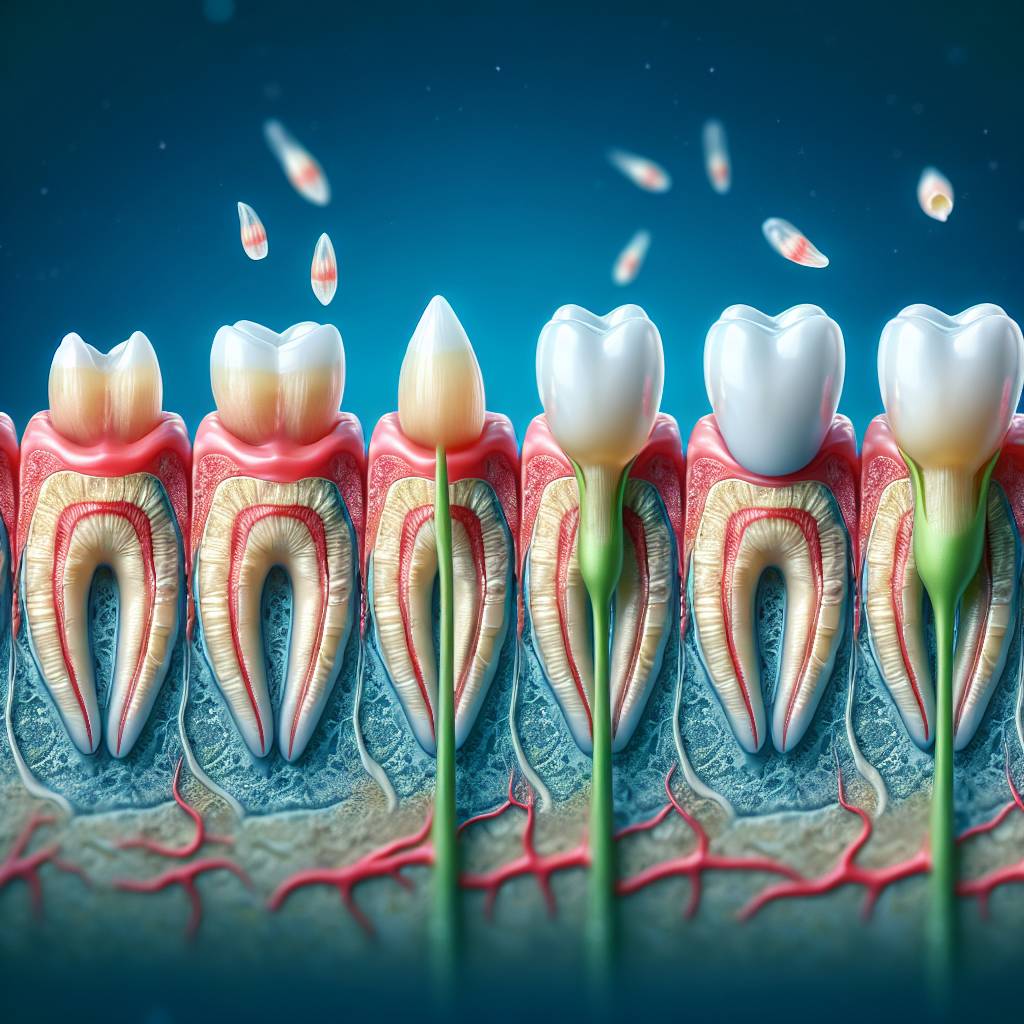Having a healthy, beautiful smile is important for many reasons. Many people are interested in knowing how long it takes to get new teeth. The answer depends on the type of procedure being done and other factors such as the patient’s individual needs and health. Generally, it can take anywhere from a few days to months to get new teeth. In this article, we’ll discuss the various factors that affect the timeline when getting new teeth.The amount of time it takes to get new teeth depends on the type of treatment you are receiving. Generally, it can take anywhere from 1-3 months to get a full set of new teeth. For procedures such as dental implants or bridges, the process may take up to 6 months.
Factors That Affect The Timeframe For New Teeth
The time it takes to get new teeth can vary greatly depending on the individual’s situation. Several factors can affect the timeframe, including the type of tooth loss, the health of the patient, and the type of treatment chosen.
Type of Tooth Loss
The type of tooth loss is one factor that influences how long it will take to get new teeth. If a person has lost a single tooth due to trauma or decay, he or she may be able to get a dental implant within a few weeks. However, if a person has lost all their teeth due to periodontal disease or other advanced conditions, the treatment process can take several months or even years.
Health of the Patient
The health of the patient is another factor that affects the timeframe for getting new teeth. For example, if a patient is not in good overall health due to other medical conditions such as diabetes or heart disease, it may take longer for him or her to heal properly after dental procedures. In addition, certain medications can slow down healing and lengthen treatment times.
Type of Treatment Chosen
The type of treatment chosen also plays an important role in determining how long it takes to get new teeth. Some treatments are more complex than others and require more time for completion. For example, traditional dentures require multiple visits over several weeks before they are ready for use while dental implants can be completed in just one visit if all goes according to plan. In addition, some treatments such as bridge work may require additional visits in order to ensure proper fit and function.
Overall, there are many factors that affect the timeframe for getting new teeth and it is important for patients to work closely with their dentist when making any decisions about treatment options. With proper planning and care from an experienced dentist, patients can expect their new smile in no time!
Dental Implant Procedures and Their Timelines
Dental implants are becoming increasingly popular as a solution to missing teeth. They offer a permanent solution to fill the gaps in your smile, making it look natural and beautiful. But before you can get dental implants, there are several procedures that need to be completed. Understanding the timeline of each of these procedures is essential for getting the best results.
The first step in the process is getting an assessment from your dentist. This involves taking x-rays and other tests to determine if you’re a good candidate for dental implants. After this assessment, your dentist will discuss with you the different types of implants available and decide which one is best for you.
Once a type of implant is chosen, your dentist will prepare the site where the implant will be placed by removing any existing teeth or bone structure that may be in the way. This process usually takes between one and two weeks, depending on how much preparation needs to be done.
Once the site has been prepared, it’s time for surgery to place the implant or implants. Depending on how many teeth need to be replaced, this procedure can take anywhere from one hour to several hours. After surgery, there is usually some recovery time needed before moving onto the next step in the process.
Following surgery, it’s time for osseointegration – a process where new bone tissue grows around and attaches itself to the implant post. This process usually takes between three and six months before moving onto the next step in treatment – placement of an abutment (a metal piece that connects an implant post with a crown).
Once an abutment has been placed, it’s time for your dentist to take impressions of your mouth so they can create a crown that matches your natural teeth perfectly. This usually takes between one and two weeks depending on how complex your case is. Once a crown has been made, it will be placed on top of your abutment and secured with screws or cement – completing your dental implant procedure.
The timeline for dental implant procedures can vary from person to person depending on their individual needs and how many teeth need to be replaced. However, most cases typically take anywhere from six months to a year before they are fully completed – making them well worth the wait!
Pros of Dental Implants
Dental implants are a great way to replace missing teeth and restore your smile. They look and feel like natural teeth, providing a permanent solution to tooth loss. Dental implants also help preserve facial structure, preventing bone deterioration that occurs when teeth are missing. In addition, they can improve the overall look and feel of your mouth and can be used to anchor bridges or dentures. Finally, dental implants are highly durable and can last for decades with proper care.
Cons of Dental Implants
The cost of dental implants is one of the main drawbacks. While the cost varies depending on the number of implants needed, the type of implant used, and where you live, it is generally more expensive than other tooth replacement options. In addition, dental implant surgery is an invasive procedure that requires anesthesia and recovery time. Finally, if you have any underlying health conditions or take certain medications, you may not be a candidate for dental implants.
Timeframes for Porcelain Veneers and Crowns
Porcelain veneers and crowns are a great way to improve your smile. The process for both treatments is relatively straightforward, but there are some differences in regards to the time it takes for each procedure. Generally, porcelain veneers take less time than crowns, as they can be created in just two visits to the dentist. During the first visit, your dentist will prepare the teeth by removing a small amount of enamel, then take impressions of the teeth and send them off to a dental lab. At your second visit, the veneers will be placed on your teeth and you’ll be able to leave with a beautiful new smile.
Crowns usually require three visits to complete. During the first visit, your dentist will prepare your teeth by removing any decay and shaping them so that they can accommodate the crown. Then impressions of your teeth will be taken and sent off to a dental lab where the crown will be crafted from porcelain or porcelain-fused-to-metal material. At your second appointment, you’ll have temporary crowns placed on your teeth until the permanent ones are ready. At your third appointment, the permanent crowns will be checked for fit and color before being cemented into place.
Both treatments require some degree of maintenance in order to maintain their longevity. With proper oral hygiene practices such as brushing twice daily and flossing regularly, as well as regular checkups with your dentist, porcelain veneers and crowns can last for many years without needing replacement or repair.

Single Tooth Replacement vs. Multiple Teeth Replacement
Replacing missing teeth is important for maintaining oral health and improving aesthetics. Deciding between single tooth replacement or multiple teeth replacement can be difficult, as both have their advantages and disadvantages. Replacing a single tooth may require only one procedure, but replacing multiple teeth may require more extensive treatment.
Single tooth replacement involves restoring a single missing tooth with an artificial one, such as an implant, bridge, or denture. This option may be suitable for patients who are only missing one tooth and want a permanent replacement that looks and functions just like a natural tooth. Single tooth replacement is usually less invasive than replacing multiple teeth, and it can help preserve the surrounding healthy teeth by not requiring them to be altered or compromised in any way.
On the other hand, replacing multiple teeth may involve using bridges or implants to replace several teeth at once. This option can be beneficial for patients who are missing several adjacent teeth as it will help restore the bite alignment and provide greater stability than if each individual tooth were replaced separately. Replacing multiple teeth also requires more extensive treatment than replacing just one, so it is important to consider all options before deciding on the best course of action for your individual needs.
In conclusion, when considering whether to replace a single tooth or multiple teeth, it is important to consider your individual needs and preferences in order to make an informed decision. Your dentist will be able to provide more guidance on which option is best suited for you based on your specific situation.
Overview of Different Types of Dentures
Dentures are removable dental appliances used to replace missing teeth. They are designed to look, feel, and function like natural teeth. Dentures come in a variety of different types, depending on the individual’s needs and situation. These include full dentures, partial dentures, implant-supported dentures, and immediate dentures.
Full Dentures
Full dentures are used when all of the teeth in an arch (upper or lower) have been lost or removed. A full denture is made of an acrylic base that sits over the gums, with a full set of replacement teeth attached to it. Full dentures are typically held in place by natural suction or with the help of an adhesive.
Partial Dentures
Partial dentures are used when some natural teeth remain in an arch. A partial denture consists of replacement teeth attached to a pink acrylic base that is designed to blend in with your gums. The base connects to a metal framework that clasps onto your remaining natural teeth for stability and support. Partial dentures can be easily removed for cleaning and maintenance.
Implant-Supported Dentures
Implant-supported dentures are a type of full or partial denture that is supported by dental implants rather than resting on your gums alone. They offer added stability and improved chewing ability, making them a popular choice for those who want more secure and comfortable fit than traditional removable dentures can provide. Implant-supported dentures require surgical placement of dental implants into the jawbone before they can be fitted and worn.
Immediate Dentures
Immediate dentures are full or partial replacements that can be placed immediately after the removal of any remaining natural teeth in an arch. This type of appliance allows you to leave your appointment with your new smile intact without having to wait weeks for your permanent set to be fabricated and fitted. Immediate dentures require more frequent adjustments as the mouth heals from tooth extraction surgery, but they make it possible for you to maintain your appearance during this transitional period until permanent solutions can be put in place.
No matter what type of dental appliance you need, it’s important to find an experienced dentist who can provide you with quality care every step of the way. Your dentist will work closely with you to help find the best solution for replacing missing teeth so you can enjoy optimal oral health and a beautiful smile once again!
Cost Considerations When Replacing Teeth
Replacing teeth can be an expensive endeavor. Dental implants, bridges, and dentures are commonly used to replace missing teeth, but there are certain cost considerations that should be taken into account before making a decision. The type of replacement chosen will depend on the extent of the damage and the budget of the individual.
Dental implants are often the most expensive option for replacing missing teeth. They require multiple visits to the dentist and involve a surgical procedure in which a titanium post is implanted into the jawbone. Additionally, they require regular maintenance and check-ups to ensure proper functioning and health of the implant.
Bridges are another option for replacing missing teeth. They involve fitting a false tooth between two crowns that are attached to existing healthy teeth on either side of the gap created by the missing tooth. Bridges tend to be less expensive than implants, but they do require regular maintenance as well as periodic adjustments by a dentist due to changes in oral health over time.
Dentures are typically seen as an ideal option for those looking for an affordable way to replace multiple missing teeth. Dentures can either be partial or full depending on how many teeth need replacing, and they can provide an aesthetically pleasing solution compared to other options. However, dentures will need to be replaced periodically due to wear and tear as well as changes in oral health over time.
Overall, cost should always be a consideration when deciding which option is best for replacing missing teeth. Implants tend to be more expensive but also offer more stability and durability than bridges or dentures; however, bridges can provide a more affordable solution with less invasive procedures than implants while still providing good aesthetics and functionality; likewise, dentures offer an even more economical approach with good aesthetics but may need frequent replacement over time due to wear and tear or changes in oral health.

Conclusion
The process of getting new teeth can take anywhere from several weeks to several months. Factors such as the type of dental procedure and the health of your mouth can affect the timeline. It is important to work with your dentist to ensure that you have a treatment plan that meets your needs and goals.
Your dentist will explain the process in detail and make sure you understand all steps involved in getting new teeth. They can also discuss if there are any risks associated with the procedure and how to minimize them.
It is important to be patient during this process, as it can take some time for the new teeth to look and feel natural. Taking good care of your mouth and following your dentist’s instructions can help ensure a successful outcome.
In conclusion, getting new teeth can be a lengthy process but one that is well worth it in the end. Working closely with your dentist is key for a successful outcome. With patience, dedication, and proper care, you can enjoy a beautiful smile for many years to come.

